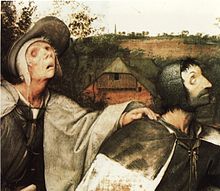The fall of the blind

|
| The fall of the blind |
|---|
| Pieter Bruegel the Elder , 1568 |
| Tempera on canvas |
| 86 × 154 cm |
| Museo Nazionale di Capodimonte |
The Fall of the Blind is a painting by the Dutch painter Pieter Bruegel the Elder . The 154 cm × 86 cm large tempera painting on canvas was created in 1568. It can be viewed today in the Museo di Capodimonte in Naples . Several copies of this picture are known, a 118 cm × 168 cm oil painting on wood is in the Louvre in Paris .
The paintings
Structure and design
The group forms a diagonal from top left to bottom right, separated from the viewer by a sudden break (lower left corner). Directly behind the first blind man there is a body of water that cuts off the group from the village houses on the other bank - in the upper right half of the picture there is a church. Bruegel depicts falling movements in different phases on the sloping terrain. The fifth figure from the left, who is about to fall like a companion into the pool, is the only one to turn to the viewer. The depiction is so precise that the cause of blindness can be determined in three of them: the third from the left suffers from a leukoma , the fourth from black star and the fifth's eyes have been gouged out .
In contrast to his dance and wedding pictures, Bruegel hardly uses color contrasts and a very reduced palette of brown and blue-gray tones.
The motif
The painting is based on the parable of the fall of the blind from the Bible . In the 15th chapter of the Gospel of Matthew Jesus says about the Pharisees : “Leave them alone, they are blind guides for the blind. But if one blind man leads the other, they both fall into the pit. " ( Mt 15,14 EU )
This motif was picked up by different painters in the Renaissance period and implemented in different ways. Bruegel relates it entirely to the time in which he lived and merely suggests the religious context.
Background and interpretation
In the Renaissance , the blind were usually depicted with their eyes closed. Bruegel proceeded differently, he looked closely at his contemporaries. There were many blind people in his world, not all of them were born from birth, rather poor hygiene and diseases played their part. In a medical work from 1585 alone 113 eye diseases are mentioned; Often there was no cure for those affected. And because the blind were dependent on alms , that is, they were felt to be lying on the pockets of others, many of them belonged to the beggars who lived ailing, ragged and neglected on the streets. Bruegel depicts his blind people accordingly. According to the Calvinist doctrine, blindness was a punishment: Those who were left in misery by God deserved it. The diagonally downward path of the group of people indicates that the rest of the group is about to fall. A white Madonna lily hangs over the water of the pool on the edge of which the first blind man fell . Lilies were considered a sign of purity and redemption; Bruegel does not say whether this will be granted to those who fall.
The importance of the church in the background is controversial among art historians. There are three different approaches that none of them could claim. Some believe that the church has no meaning, as Bruegel often integrated such into his pictures. Others explain, with regard to the religious background, that the withered little tree in front of her (almost just a dry branch) signals that she, being led by Pharisees , has become useless. A third group, on the other hand, sees a moral clue in the special position that the church occupies in the picture: It is not by chance that it is placed between the two blind men who have already fallen and the group of the last four: This indicates that the first two lost, but the other four can still be saved.
The building can be identified as the village church of St. Anna near Brussels .
reception
- Elias Canetti gives in the chapter “Simsons Blendung” of the second volume of his autobiography, Die Fackel im Ohr (page 111), a pictorial description of this painting, which - like the blinding of Samson - has a key motivic function for his novel Die Blendung .
- With the story Der Blindensturz (Darmstadt 1985), Gert Hofmann contrasted the master picture with a master story about the painting.
literature
- Jürgen Müller : Of churches, heretics and other blind leaders - Pieter Bruegels d. Ä. The fall of the blind and the aesthetics of subversion ; In: Piltz, Eric (ed.): Godlessness and stubbornness: Religious deviance in the denominational age , Duncker and Humblot, Berlin 2015, ISBN 978-3-428-14481-5 pp. 493-530.
- Rose-Marie Hagen, Rainer Hagen: Masterpieces in detail . Volume 2. Taschen Verlag, Cologne et al. 2003, ISBN 3-8228-1371-0 .
- Heinke Sudhoff: Iconographic investigations on the "healing of the blind" and on the "blind fall". A contribution to Pieter Bruegel's Neapler painting from 1568 . Bonn 1981, (Bonn, Univ., Diss., 1980).
See also
supporting documents
- ^ Rose-Marie and Rainer Hagen –- Pieter Bruegel the Elder. Ä. - Farmers, fools and demons, Cologne: Benedikt Taschen Verlag GmbH 1999 p. 80
- ↑ Pieter Bruegel the Elder Ä. - Peasants, fools and demons , p. 75
- ↑ Gerhard Larchner / Karl M. Woschitz - Religion, Utopia, Art: the city as a focus , Vienna: Lit-Verlag 2005 S. 57 ISBN 3-8258-7724-8



